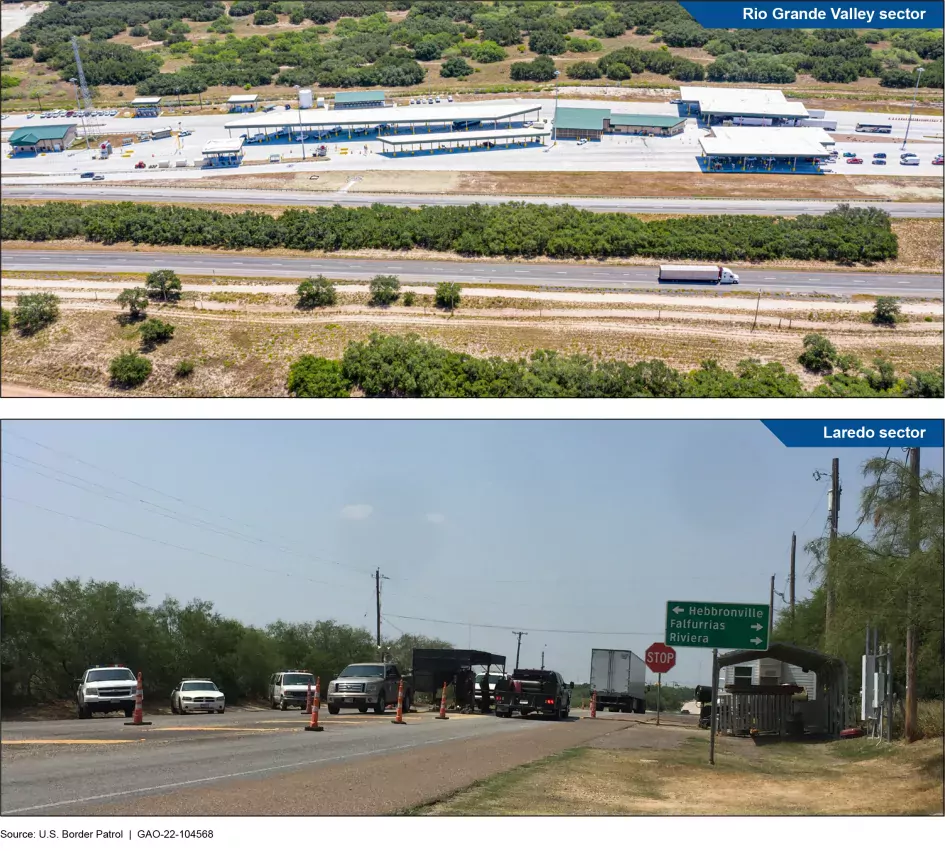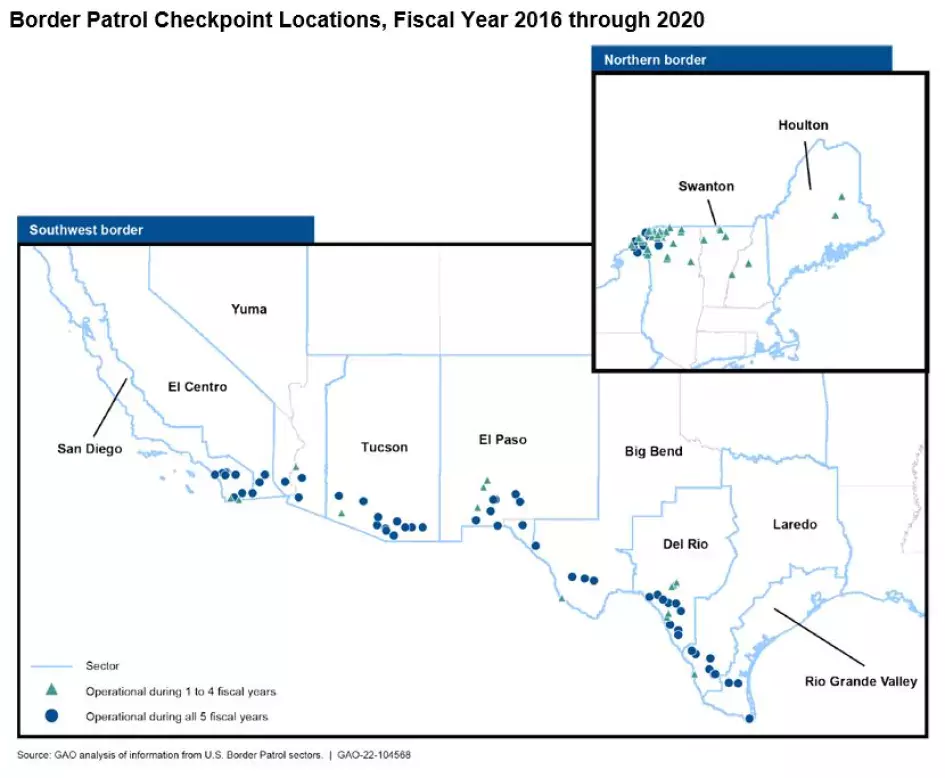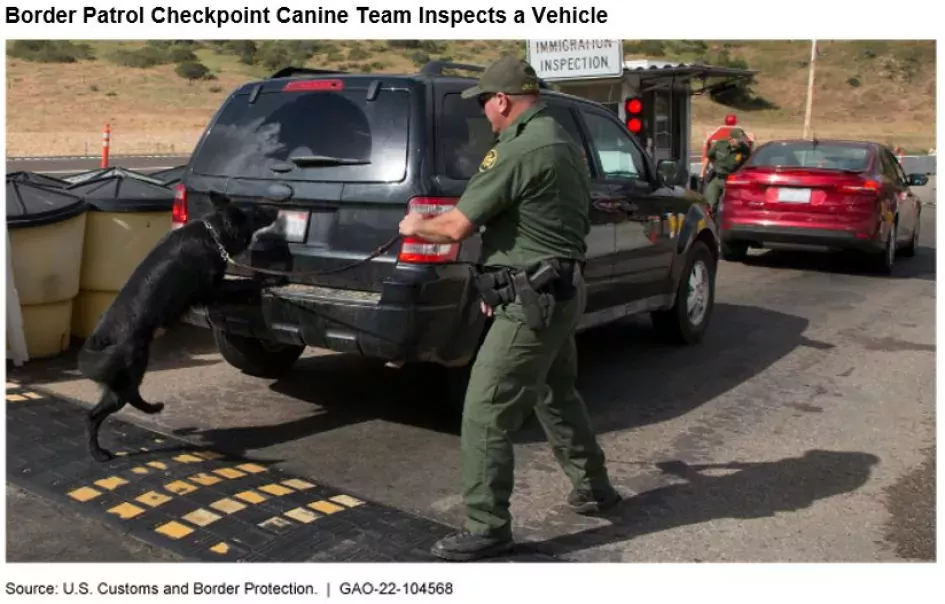Border Patrol Lacks Important Information about Immigration Checkpoints Within the United States
Each year, more than 50 million vehicles pass through U.S. Border Patrol’s interior immigration checkpoints. There are more than 110 checkpoints, located generally 25 to 100 miles from the southwest and northern borders along U.S. highways and secondary roads. All vehicles traveling through a checkpoint may be subject to a checkpoint inspection.
U.S. Border Patrol, an agency within the Department of Homeland Security’s U.S. Customs and Border Protection, is responsible for securing U.S. borders between official ports of entry and for preventing the illegal flow of people and contraband, such as drugs, from entering the country. At checkpoints, Border Patrol agents screen vehicles to identify people who may be in the U.S. unlawfully. Agents may also enforce U.S. criminal law, such as by seizing illegal drugs or executing outstanding warrants.
To aid their mission, Border Patrol collects data on checkpoint apprehensions (of people who are unlawfully in the U.S.) and drug seizures. However, in our new report issued earlier this month, we found problems with Border Patrol’s oversight of checkpoints and with data agents collect about other law enforcement activity at checkpoints.
Today’s WatchBlog post takes a look at what we found.
Images of Checkpoints
Image

How does Border Patrol manage and oversee checkpoints?
In our new report, we looked at how Border Patrol operates and oversees its checkpoints to ensure that they are working as intended. Operations at checkpoints are overseen by individual Border Patrol sectors (field offices) and by Border Patrol’s headquarters, which staffed a management office to oversee checkpoint operations in 2016.
However, in our new report, we found that Border Patrol had not established clear roles and responsibilities for its headquarters management office. We also found that this office was not consistently and adequately staffed, and that newly assigned staff may not have had all the information they needed to carry out the office’s activities. As a result, the management office has not fulfilled its intended role, which means that Border Patrol headquarters does not have complete information about where and how checkpoints operate or about their activities.
In our report, we recommended actions to help Border Patrol address these oversight gaps.
Image

What did Border Patrol find during checkpoint inspections?
From fiscal years 2016 through 2020, Border Patrol apprehended about 35,700 people who may have been in the U.S. unlawfully in 17,500 events at checkpoints.
During the same period, agents seized drugs in about 17,970 checkpoint events. Most drug seizures (91%) were from inspections with only U.S. citizens in the vehicle. Of these U.S. citizen drug seizures, 75% included marijuana and no other drugs.
Image

Border Patrol records information about what it finds at checkpoints and uses this data to inform its efforts. We looked at the data Border Patrol collects and found that while checkpoint data on apprehensions and drug seizures were generally reliable, other data were unreliable. This included data on: apprehensions of smuggled people, canine assists with drug seizures, people involved in all law enforcement encounters at checkpoints, and non-drug property seizures (including vehicle seizures).
Without reliable checkpoint data, Border Patrol does not have the information it needs to assess checkpoint effectiveness, ensure proper resource allocation, or explain checkpoint operations.
To learn more about our recommendations to Border Patrol regarding checkpoint oversight and data collection, among other issues, check out our report on immigration checkpoints.
- Comments on GAO’s WatchBlog? Contact blog@gao.gov
GAO Contacts
Related Products

GAO's mission is to provide Congress with fact-based, nonpartisan information that can help improve federal government performance and ensure accountability for the benefit of the American people. GAO launched its WatchBlog in January, 2014, as part of its continuing effort to reach its audiences—Congress and the American people—where they are currently looking for information.
The blog format allows GAO to provide a little more context about its work than it can offer on its other social media platforms. Posts will tie GAO work to current events and the news; show how GAO’s work is affecting agencies or legislation; highlight reports, testimonies, and issue areas where GAO does work; and provide information about GAO itself, among other things.
Please send any feedback on GAO's WatchBlog to blog@gao.gov.




